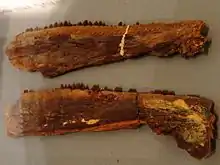Saurocephalus
Saurocephalus is an extinct genus of fishes within the family Saurodontinae.[9][10] The genus was first described in 1824 and contains six or seven species, including the type species S. lanciformis.[1] Saurocephalus first appeared during the early Valanginian and continued on to the Maastrichtian, when it went extinct.[6]
| Saurocephalus | |
|---|---|
 | |
| Two jaws of S. lanciformis | |
| Scientific classification | |
| Kingdom: | |
| Phylum: | |
| Class: | |
| Order: | Ichthyodectiformes |
| Suborder: | †Ichthyodectoidei |
| Family: | |
| Subfamily: | |
| Genus: | †Saurocephalus Harlan, 1824[1] |
| Type species | |
| †Saurocephalus lanciformis Harlan, 1834[1] | |
| Other species[2] | |
| |
| Synonyms | |
Saurocephalus is almost entirely represented by fragmentary specimens with the exception of a few complete specimens, such as a near-complete specimen of the species S. longicorpus from Jordan.[6] The complete material from Jordan offered an extensive amount of valuable information about Saurocephalus.[6] With an elongate, torpedo-like body, Saurocephalus was extremely fast and it was probably a formidable open water ambush predator. The morphology of its teeth and jaw structure suggest it was a piscivore. The closely set very sharp and firmly anchored teeth lined up along the upper and lower jaws acted together like sharp serrated scissors. The ventral extension of the upper jaw deep unto the sides of the lower jaw made the jaws perform like meat slicers. Saurocephalus was a powerful and ferocious predator with a powerful jaw capable of slicing and biting off large chunks of meat from its potential prey items - no doubt, fish was on top of the diet list. To process large prey, it would cut them into smaller more manageable pieces using its large jaws and serrated teeth. A close modern analogue of Saurocephalus and to the matter saurodontids, would be barracudas (Sphyraena barracuda), known to ambush, ram, and stun their prey using the strong anterior projection of the dentary. Although not as notably elongate, the overall body outline of barracudas is similar to Saurocephalus.[11]
References
- Harlan, R. 1824. On a new fossil genus of the order Enalio Sauri, (of Conybeare). Journal of the Academy of Natural Sciences of Philadelphia. Series 1, 3(pt. 2): 331-337.
- O. P. Hay. 1902. Bibliography and Catalogue of the Fossil Vertebrata of North America. Bulletin of the United States Geological Survey 179:1-868
- A. Jaccard. 1869. Jura Vaudois et Neuchatelois. Matériaux pour la carte géologique de la Suisse 6:1-340
- Hebert, E. 1855. Tableau des fossiles de la Craie de Meudon. Memoires de la Societe geologique de France, 2 5(4): 345-374.
- E. E. Tawadros. 2001. Geology of Egypt and Libya. Rotterdam: AA Balkema.
- Kaddumi, H. F. 2009. Saurodontids (Ichthyodectiformes: Saurocephalus) of Harrana with a description of a new species from the late Maastrichtian Muwaqqar Chalk Marl Formation. In: Fossils of the Harrana Fauna and the Adjacent Areas. Publications of the Eternal River Museum of Natural History, Amman, pp 215-231.
- Cope, E. D. (1870). On the Saurodontidæ. Proceedings of the American Philosophical Society 11:529-538
- Cope, E. D. (1873). On two new species of Saurodontidae. Proceedings of the Academy of Natural Sciences of Philadelphia 25:2-339
- Maisey, J. G.1991. Santana Fossils, an Illustrated Atlas. New Jersey, T.F.H. Publications Inc., 190–207.
- Saurocephalus, Saurodon and Prosaurodon, sword-eels of the Late Cretaceous
- Bardack, D. and G. Sprinkle. 1969. Morphology and relationships of saurocephalid fishes. Fieldiana Geology 16(12):297-340.